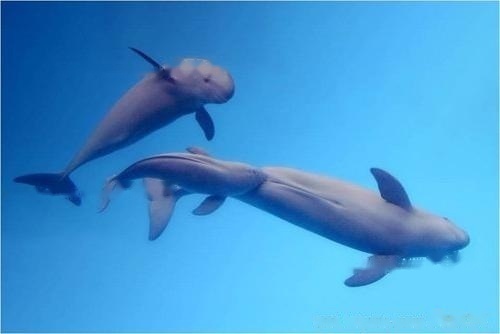The mating of finless porpoises usually takes 30 to 60 minutes from the start of the intense chase between male and female dolphins to the end of mating. It can occur more than ten times a day, and there is no distinction between day and night. When chasing a female, the male dolphin swims back and forth on the abdomen and tail handle, and there are various postures such as tumbling, side swimming, and back swimming. The water surface is often stirred up with waves and splashes. When escorting, the male and female dolphins emerge parallel to the water surface or dive into the water, and different parts of their bodies touch and rub against each other. When the estrus reaches a certain level, they will face each other on the ventral surface, the genital fissure is close, and the male dolphin will expose the genitals and continue to swim together until the male dolphin's genitalia is inserted into the female animal's vagina to achieve union. The water was relatively calm at this time, and after about 2 minutes, the mating ended. The male and female dolphins slowly emerge from the water and then separate.

About 10 days before giving birth, the female dolphin's breathing rate increased day by day, and her food intake gradually decreased. By 5 days before delivery, the papillary fissures and genital fissures gradually enlarged, opened, and the nipples protruded. Swimming often stops at the surface of the water, and the body sways from side to side, as if losing balance. About 25 hours before labor begins, the vulva opens further, and a milky white fluid flows out of the vaginal opening. During childbirth, the vaginal opening is forked, and it swims up and down and rolls every 3 minutes or so. It lasts for about 2 to 3 minutes and then swims slowly, and then swims rapidly again after a 3-minute interval. Every time the female dolphin swam hard, so that the cubs could give birth a little, but as soon as they loosened up, the cubs retracted again. It was not until after a pause that the female dolphin suddenly and continuously exerted force to deliver the fetus as a whole. The cub immediately struggled to swim upwards, while the female dolphin was belly-side up, swimming in the opposite direction to the cub, pulling the umbilical cord. . The cub dashed out of the water, breathing the air. The entire delivery process takes about 160 minutes.
October, 1 cub per litter. The female dolphins have obvious behaviors of protecting and helping the cubs, such as piggybacking and carrying, which are very interesting. When being piggybacked, the cub's head, neck and abdomen are close to the female dolphin and lie on the back, and the cub and the female dolphin emerge from the water one after another when breathing. When the cubs grow up, the female dolphins often use flippers or tails to support the cubs' jaws or other parts of the body to swim, and they also emerge from the water one after another when breathing. The way of carrying is more common. The female dolphin and the cub are very close, about 5 to 10 meters apart, but they do not touch the body, and they also emerge from the water one after the other. During lactation, female dolphins and their cubs often appear in shallow and gentle areas of water. The female dolphin's body is turned slightly to one side, and one flipper is exposed, while the cubs are close to the female dolphin's abdomen. The time is about 5 to 10 minutes. Sometimes the male dolphins also participate in raising the young, allowing the young to swim between the male and female dolphins, but generally closer to the female dolphin, the family floats up and down in the water at the same time, and emerges almost parallel to the surface. The female finless porpoise is very maternal. If the cubs are unfortunately captured, the female dolphins often cannot bear to discard them, so they are often arrested at the same time.
![[Dog Training 5] The training method of pet dog dining etiquette](/static/img/12192/12192_1.jpg)




